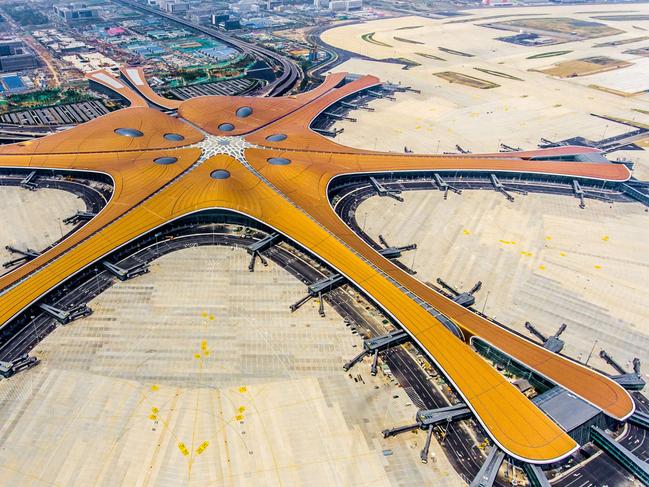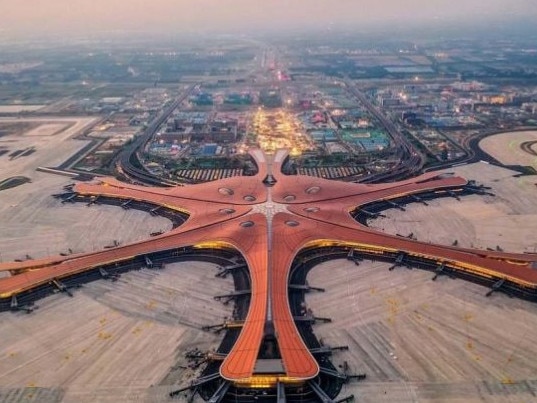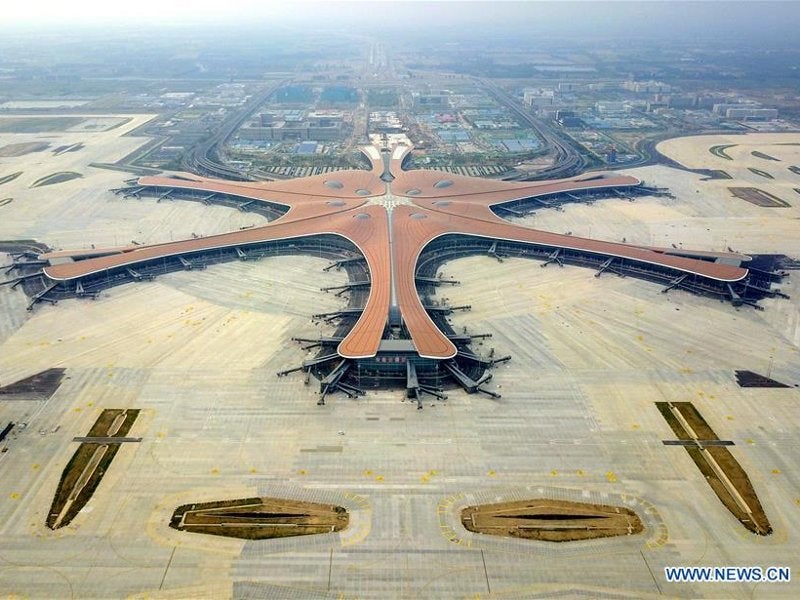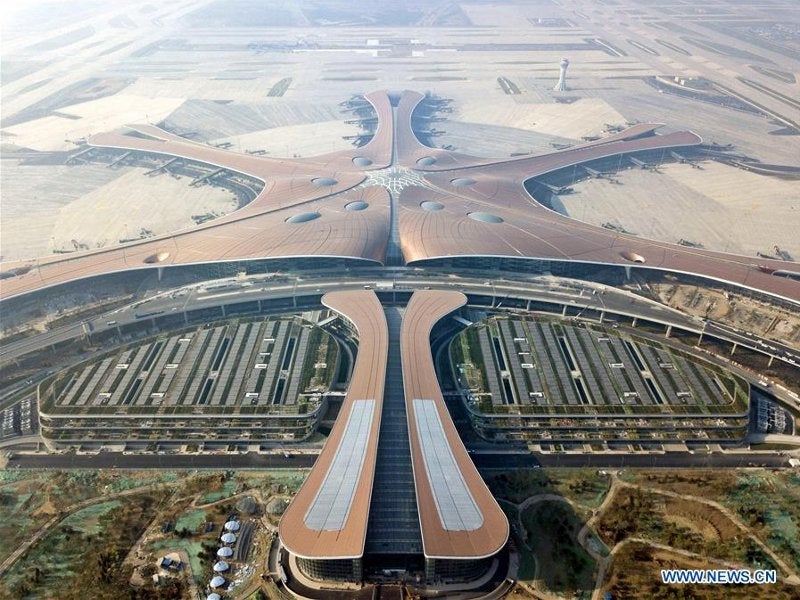The Beijing Daxing International Airport will be the first airport to have double-deck arrival and departure platforms. Images courtesy of Xinhua/Ju Huanzong.

The Beijing Daxing International Airport is expected to handle 72 million passengers and 2 million tonnes of cargo. Images courtesy of Xinhua/Zhang Chenlin.
The Beijing Daxing International Airport will have four runways for civilian and one for military use. Images courtesy of Xinhua/Cai Yang
West control tower of the airport was inaugurated in June 2019. Images courtesy of Xinhua/Zhang Chenlin.

Beijing, the capital city of the Republic of China, is one of the largest cities in the world. It has only one international airport and a military air base, while cities that are esteemed on par with it accommodate two or more international airports.
The city is served by the Beijing Capital International Airport, which is the world’s second largest in terms of passenger traffic. The airport is currently running at maximum capacity and cannot be expanded further.
The Government of China announced the long-awaited approval for construction of a new international airport in January 2013. The airport has been built in Daxing, a suburb district south of the city. It will reduce congestion at the existing airport and cater to needs of Beijing passengers.
The new airport is incurred an approximate expenditure of CNY120bn ($17.46bn), while the projects in its periphery attracted investments of CNY330bn ($48bn). It is expected to handle 72 million passengers and two million tonnes of cargo annually by 2025.
Construction work commenced in December 2014 and the steel structure of the terminal was formed in June 2017. Construction of the airport was completed in June 2019 and the airport is expected to begin operations in September 2019.
Construction of a new airport will place Beijing alongside some of the most prominent cities in the world. The airport is expected to replace the US’s Hartsfield-Jacksondiy2k.blogspot.com Atlanta International Airport as the world’s busiest.
The need for a new airport in Beijing
“Approximately 205,000 passengers pass through the airport daily and it is not possible to expand the airport to handle 370,000.”
Beijing Daxing International Airport design and features
“The airport is expected to replace the US’s Hartsfield-Jackson Atlanta International Airport as the world’s busiest.”
“Approximately 205,000 passengers pass through the airport daily and it is not possible to expand the airport to handle 370,000.”
Beijing Daxing International Airport design and features
“The airport is expected to replace the US’s Hartsfield-Jackson Atlanta International Airport as the world’s busiest.”
Beijing Capital International Airport has an annual passenger handling capacity of 75 million. In 2012, the airport handled 82 million passengers, an increase of 4.1% over the previous year. The airport is expected to reach saturation within the next two years. The situation is expected to worsen and make it difficult for the passengers to move freely in the terminal.
Approximately 205,000 passengers pass through the airport daily and it is not possible to expand the airport to handle 370,000 passengers.
The airport currently occupies an area of 2,100ha. An expansion will make it difficult to operate such a large airport. The recently constructed terminal three, which is as big as London’s Heathrow Airport, is also running at maximum capacity.
With an increase in economic growth and urbanisation, the city has witnessed massive migration from rural areas. This has placed further stress on the existing transport facilities, including air travel.
In addition, Beijing’s expanding economic growth has attracted an increasing amount of business travellers. Over the next few years, the city is expected to witness a large number of passengers travelling in and out of the country. Many of these passengers are expected to be business travellers.
Proposals for the construction of a second airport for Beijing have been under discussion for more than a decade but were not implemented. The growth of the city has, however, necessitated the construction of a new airport.
Beijing Nanyuan Airport, which is currently serving as the second airport for the city, is expected close after the new airport is inaugurated.
The Beijing Daxing International Airport is built on a 2,679.01ha (6,620 acres) site located 46km south of Beijing’s political centre, Tiananmen Square.
The project includes construction of airline bases, intercity railway, high-speed subway, highway, air traffic control tower.
Netherlands Airport Consultants (NACO), a Dutch airport consulting firm, won the bid to design the new airport’s master plan. The airport has four runways and one military runway. Beijing Daxing is the first airport in the world with double-deck departure and arrival platforms.
Special care has been taken by NACO to incorporate sustainable elements into the master plan of the airport. The terminal building covers 313,000m2 and features a central building with six arms, resembling a phoenix spreading wings from the aerial view.
The Beijing Daxing International Airport will use facial recognition for secure access to the airport and radio frequency identification devices for baggage tracking.
The airport is designed so the distance between far-end of the terminal to the centre is 600m.
The landside terminal of the airport operated by China Resources Land consists of childcare and nursery, interactive pet hotels, hybrid online retail and dining places and showrooms.
China Southern Airlines and China Eastern Airlines will operate from the Daxing airport along with other SkyTeam Airline Alliance members.
The Beijing Daxing International Airport incorporates energy saving green concepts, allowing natural light into the building. Renewable energy accounts for more than 10% of the energy consumed by the airport. Other traditional sources will also be used to meet the needs of the airport.
The airport features a solar farm with photovoltaic cells mounted on the roof of the car park building, hangars and cargo areas. A 100% rainwater collection facility is installed to cater to its energy and resource needs.
Heating and cooling systems of the airport are powered by geothermal heat pumps located at the Yongding River basin. Energy from the pumps is expected to meet 8% of the energy required by the airport.
The departure lounges open to five courtyards designed in ancient Chinese-style featuring silk, tea, porcelain, courtside and Chinese gardens.
The new airport implements latest technology such as passenger self check in facility, which will be available for 86% of passengers and self baggage check-in serving 76% of the passengers. Use of clean energy vehicles will also reduce the carbon footprint of the airport.
Beijing Daxing International Airport will be integrated to the city through multiple means of transportation facilities. Its design includes various types of ground transport systems such as high-speed trains, metro and inter-airport trains.
All transport systems will be operated through a ground transportation centre constructed in front of the terminal building.
The Beijing New Airport Headquarters formed a joint design team comprising ADP Ingeniérie (ADPI) and Zaha Hadid Architects (ZHA) to develop a concept design for the Beijing New Airport terminal building in October 2014. The concept design was completed in February 2015.
International design studio Lead 8 was selected as the lead designer for the new commercial terminal in August 2018.



Comments